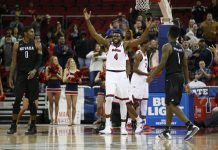PHOENIX (AP) The NCAA has used the RPI as a metric to help it pick the NCAA Tournament field for more than three decades.
The analytics system may be ready for an upgrade.
The NCAA recently met with some of the best statistical minds in college basketball to explore new metrics for selecting the 36 at-large teams and seeding the 68 teams in the NCAA Tournament. No decisions were made and no changes are imminent, but progress was made toward finding a system to enhance the process.
”We learned a lot, but in some ways it raised additional questions,” said Dan Gavitt, NCAA senior vice president of basketball. ”That’s good, that’s all part of the process of it. It was very educational, but we’ve got more work to do on it.”
The Jan. 20 meeting in Indianapolis brought together Ken Pomeroy of KenPom.com, Jeff Sagarin of Sagarin.com (and USA Today), KPI proprietor Kevin Pauga and ESPN’s Ben Alamar with NCAA officials to discuss ways of implementing more analytics in the tournament seeding and bracketing process.
The RPI has been a part of the process since 1981, but the National Association of Basketball Coaches asked the NCAA to look at using more advanced metrics. The goal is to put a finer point on the data that helps determine the 36 at-large teams and seeding for every team for the tournament.
”I think it’s a good time to take a fresh look at what makes the most sense to sort, what makes the most sense for seeding teams,” said Mark Hollis, NCAA Tournament selection committee chair and athletic director at Michigan State. ”Everything’s on the table for the future.”
The analytical world of college hoops breaks down into two main metrics: predictive, like KenPom, Sagarin, BPI, and results-oriented, like RPI and KPI.
The NCAA must determine how much of each side should be used or whether to create a composite of multiple methods. It also must find a system that is easily understandable; get too deep in the woods and teams, coaches and fans will not understand it, and complaints about the system would surely skyrocket.
One possibility would be to use results-based metrics for selecting teams, predictive metrics to seed them.
”There was a lot of talk around which is better: Is one more appropriate for selecting teams, another better for seeding the teams once the field is selected?” Gavitt said. ”There’s a lot that has to go into thinking about that.”
Finding the right mix of analytics is not going to be easy. Each system incorporates inordinate amounts of data points and, frankly, a lot of decimal points for selection committee members to digest. Each one can produce an outlier as well, which could lead the NCAA to create some sort of composite.
Gavitt said some of what was discussed will likely be shared with the NABC board and with members at the Final Four in Phoenix, with discussions continuing until at least the NCAA’s July basketball meeting. The hope is to have something in place for the 2017-18 season, but the main goal is to get it right first.
”Right now, it’s just a discussion with really good minds to put those together and see where that goes,” Hollis said.
The analytical ball is rolling.
—
More AP college basketball: www.collegebasketball.ap.org and https://twitter.com/AP-Top25
25% Bonus via Western Union

















